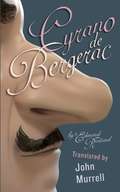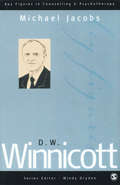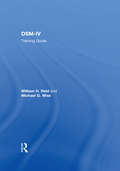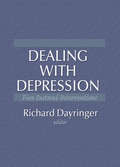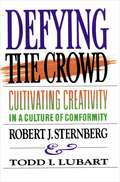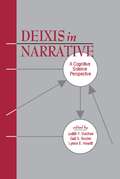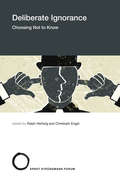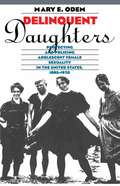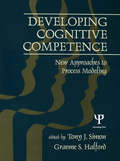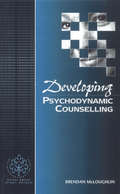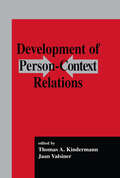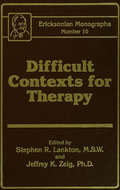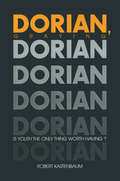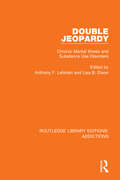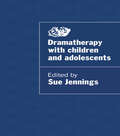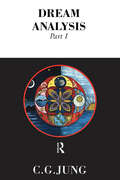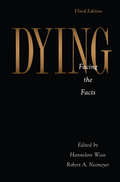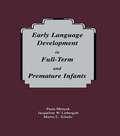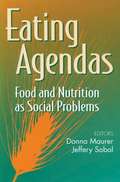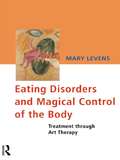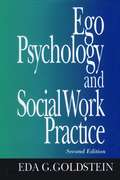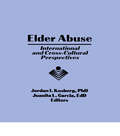- Table View
- List View
Cyrano de Bergerac
by Edmond Rostand John MurrellThis beloved classic has fascinated and enchanted generations. Not since 1938 has there been a more readable or stageable prose translation. Its fast-paced plot and rich tapestry of gallant soldiers, starving poets, musketeers, marquises, and bluestockings delight, but at its heart is Cyrano: masterful soldier, accomplished poet, ferocious orator, chivalrous lover... and the possessor of an extraordinary nasal appendage!
D. W. Winnicott (Key Figures in Counselling and Psychotherapy #8)
by Michael Jacobs`The importance of Michael Jacobs' book lies in his attempt to convey. . . Winnicott's profound influence. . . . Jacobs rightly delights in the creativity and imagination of his subject and illustrates these with numerous quotations and descriptions from Winnicott's writings. . . . What is conveyed throughout the book is the essence of Winnicott. . . . [whose] gift was to make psychoanalytic language, methods and concepts more widely available, accepted and appreciated to a nonpsychoanalytic world' - British Psychological Society Counselling Psychology Review One of the best-known British psychoanalysts, D W Winnicott attracts the interest of counsellors and psychotherapists far beyond the strict psychoanalytic tradition in which he was trained. He coined many phrases that have entered the discourse of therapy, such as `good enough mother', `transitional object' and `facilitating environment'. Winnicott has had a profound impact on research into the mother-baby relationship, and his unorthodox manner and sparkling writing style have attracted enthusiastic acclaim. In this book, Michael Jacobs summarizes Winnicott's life and explains his major theoretical concepts. He also rigorously evaluates his practice as a clinician - for example, the holding and management of deeply regressed patients. While highlighting Winnicott's brilliance and creativity, Jacobs is not afraid to scrutinize his contributions more critically. He also discusses criticisms others have made of Winnicott, notably within the psychoanalytic movement. The final chapter assesses the influence of Winnicott's thinking in other countries as well as in Britain.
DSM-IV Made Easy: The Clinician's Guide to Diagnosis
by James MorrisonThis book takes the reader through a step-by-step diagnostic process for every DSM-IV category, and explains how to derive a complete five-axis diagnosis. Each set of criteria is discussed in detail, illustrated by vivid clinical vignettes and interpreted in lucid terms.
DSM-IV Training Guide
by William H. Reid Michael G. WiseFirst published in 1995. Following on from two previous books that focused on the treatment of the DSM-III and DSM-III-R psychiatric disorders. This book is devoted to training clinicians on the proper use of the DSM and offers a great contribution to the education of mental health professionals. Written by experts in forensic psychiatry and medical education this is a clear and comprehensiveness DSM -IV Training Guide.
Dealing with Depression: Five Pastoral Interventions
by William M Clements Richard L DayringerThis important book explores strategies to enable clergy and lay persons to identify and help individuals suffering from depression. It contains many techniques that can be used in managing depression, including coping devices, treatments, and interventions which actually help depressed persons to improve their mental health. Dealing With Depression describes types of depression and related symptoms to help clergy develop a more complete understanding of the disorder. They will learn to recognize the symptoms of depression and be better able to help individuals who suffer from it. This useful guide includes a step-by-step approach to depression intervention and proven techniques readers can use to enable people to cope more successfully with depression. This important book has also been translated into a Chinese version. Dealing With Depression brings together expert psychologists who explore five modalities for conceptualizing and managing depression, which deflates for clergy the often intimidating quality of the disorder. These experts discuss in practical and understandable ways the helping techniques they use and explain their understanding of depression and their methods of treatment. A medical-religious case conference with these experts shows how clergy and laity can help ease depression and an extensive bibliography is included to facilitate further reference. Dealing With Depression puts this common disorder back into the human life situation where it can be seen as just another temporary disturbance to which human beings are vulnerable, but which need not significantly distort their lives, relationships, spiritual development, or prosperity of body, mind, and soul.
Defying the Crowd: Cultivating Creativity in A Culture of Conformity
by Robert J. Sternberg Todd I. LubartWorld renowned psychologist Robert Sternberg presents a fresh and compelling picture of the creative process from the inception of an idea to its ultimate success. With illuminating examples, Sternberg reveals the paths we all can take to become more creative and shows how institutions can learn to foster creativity.
Deixis in Narrative: A Cognitive Science Perspective
by Judith F. Duchan Gail A. Bruder Lynne E. HewittThis volume describes the theoretical and empirical results of a seven year collaborative effort of cognitive scientists to develop a computational model for narrative understanding. Disciplines represented include artificial intelligence, cognitive psychology, communicative disorders, education, English, geography, linguistics, and philosophy. The book argues for an organized representational system -- a Deictic Center (DC) -- which is constructed by readers from language in a text combined with their world knowledge. As readers approach a new text they need to gather and maintain information about who the participants are and where and when the events take place. This information plays a central role in understanding the narrative. The editors claim that readers maintain this information without explicit textual reminders by including it in their mental model of the story world. Because of the centrality of the temporal, spatial, and character information in narratives, they developed their notion of a DC as a crucial part of the reader's mental model of the narrative. The events that carry the temporal and spatial core of the narrative are linguistically and conceptually constrained according to certain principles that can be relatively well defined. A narrative obviously unfolds one word, or one sentence, at a time. This volume suggests that cognitively a narrative usually unfolds one place and time at a time. This spatio-temporal location functions as part of the DC of the narrative. It is the "here" and "now" of the reader's "mind's eye" in the world of the story. Organized into seven parts, this book describes the goal of the cognitive science project resulting in this volume, the methodological approaches taken, and the history of the collaborative effort. It provides a historical and theoretical background underlying the DC theory, including discussions of deixis in language and the nature of fiction. It goes on to outline the computational framework and how it is used to represent deixis in narrative, and details the linguistic devices implicated in the DC theory. Other subjects covered include: crosslinguistic indicators of subjectivity, psychological investigations of the use of deixis by children and adults as they process narratives, conversation, direction giving, implications for emerging literacy, and a narrator's experience in writing a short story.
Deliberate Ignorance: Choosing Not to Know (Strüngmann Forum Reports #29)
by Ralph Hertwig Christoph EngelPsychologists, economists, historians, computer scientists, sociologists, philosophers, and legal scholars explore the conscious choice not to seek information.The history of intellectual thought abounds with claims that knowledge is valued and sought, yet individuals and groups often choose not to know. We call the conscious choice not to seek or use knowledge (or information) deliberate ignorance. When is this a virtue, when is it a vice, and what can be learned from formally modeling the underlying motives? On which normative grounds can it be judged? Which institutional interventions can promote or prevent it? In this book, psychologists, economists, historians, computer scientists, sociologists, philosophers, and legal scholars explore the scope of deliberate ignorance.
Delinquent Daughters: Protecting and Policing Adolescent Female Sexuality in the United States, 1885-1920
by Mary E. OdemDelinquent Daughters explores the gender, class, and racial tensions that fueled campaigns to control female sexuality in late nineteenth- and early twentieth-century America. Mary Odem looks at these moral reform movements from a national perspective, explores the local enforcement of regulatory legislation in Alameda and Los Angeles Counties in California and shows that the paradoxical consequences of reform often resulted in coercive and discriminatory policies toward working-class girls.
Developing Cognitive Competence: New Approaches To Process Modeling
by Tony J. Simon Graeme S. HalfordAlthough computational modeling is now a widespread technique in cognitive science and in psychology, relatively little work in developmental psychology has used this technique. The approach is not entirely new, as a small group of researchers has attempted to create computational accounts of cognitive developmental phenomena since the inception of the technique. It should seem obvious that transition mechanisms -- or how the system progresses from one level of competence to the next -- ought to be the central question for investigation in cognitive developmental psychology. Yet, if one scans the literature of modern developmental studies, it appears that the question has been all but ignored. However, only recently have advances in computational technology enabled the researcher access to fully self-modifying computer languages capable of simulating cognitive change. By the beginning of the 1990s, increasing numbers of researchers in the cognitive sciences were of the opinion that the tools of mathematical modeling and computer simulation make theorizing about transition mechanisms both practical and beneficial -- by using both traditional symbolic computational systems and parallel distributed processing or connectionist approaches. Computational models make it possible to define the processes that lead to a system being transformed under environmental influence from one level of competence observed in children to the next most sophisticated level. By coding computational models into simulations of actual cognitive change, they become tangible entities that are accessible to systematic study. Unfortunately, little of what has been produced has been published in journals or books where many professionals would easily find them. Feeling that developmental psychologists should be exposed to this relatively new approach, a symposium was organized at the biennial meeting of the Society for Research in Child Development. The "cost of entry" was that speakers had to have a running computational model of a documented cognitive transition. Inspired by that conference, this volume is the first collection where each content chapter presents a fully implemented, self-modifying simulation of some aspect of cognitive development. Previous collections have tended to discuss general approaches -- less than fully implemented models -- or non self-modifying models. Along with introductory and review chapters, this volume presents a set of truly "developmental" computational models -- a collection that can inform the interested researcher as well as form the basis for graduate-level courses.
Developing Psychodynamic Counselling (Developing Counselling series #4)
by Brendan Mcloughlin`This book deals with many aspects of psychodynamic counselling from the minutiae of the extrinsic context, such as decor, through the "therapeutic stance of attentive reserve" on to an elaboration of the elements of a therapeutic relationship. . . the book is liberally garnished with case studies. . . informative and thought-provoking. . . a useful resource to those teaching psychodynamic principles. . . If you are new to psychodynamic work, this book could be a safe and helpful guide. . . The ideas and techniques offered by the author may also prove intriguing and even inspiring to those (like me) from a different therapeutic orientation' - The International Journal of Social Psychiatry Psychodynamic counselling has developed from the psychoanalytic tradition inaugurated by Freud. At its core is a belief in the role of the unconscious in the development of conflict and disturbance, which may be resolved through the careful unfolding of the therapeutic relationship via the transference/counter-transference dynamic and within a defined setting. Integrating theory and context, this book explores the opportunities for counsellors to develop their own practice of psychodynamic counselling. The author encourages readers to look carefully at the way they work and to think about strategies to improve their skills in a specialized form of relating. He examines areas crucial to the psychodynamic approach, including internal and external settings, working with issues around boundaries, and transference and counter-transference.
Development of Person-context Relations
by Jaan Valsiner Thomas A. KindermannnTraditionally, developmental psychology has its focus on individuals. Developmentalists aim to describe regularities in individuals' change and development across time, to explain the processes and mechanisms that are involved in producing change and regularity, and eventually, to design strategies for optimization and modification of developmental pathways. Although the role of contexts has always been of central concern for these purposes, it is nevertheless quite surprising to note that compared to the effort devoted to individuals, relatively little attention has been paid to the study of the nature and organization of their contexts. This volume is an exploration of the idea that how we describe and explain human development will be closely tied to our understanding of what contexts are, how individuals and contexts become influential for one another, what contexts do to and with individuals, and how contexts and their influences change themselves across time. A major theme is whether the traditional dichotomy between individuals and their contexts may be artificial, perhaps culturally biased, and after psychologists have adhered to it for about a century, may have become an impediment to increasing our understanding of developmental processes. With this volume, the editors contribute a serious consideration of development and systematic change to emerging models of person-context relations, and provide suggestions about how it may be possible to incorporate these notions in developmental research and theorizing.
Difficult Contexts For Therapy Ericksonian Monographs No.: Ericksonian Monographs 10
by Stephen R. Lankton and Jeffrey K. ZeigFirst published in 1995. The Ericksonian Monographs publish only original manuscripts dealing with Eriksonian approaches to hypnosis, family therapy and psycho-therapy, including techniques, case studies, research and theory. This is No 10 and contains 11 articles from internationally recognised experts on Ericksonian therapy.
Dorian Graying: Is Youth the Only Thing Worth Having? (Society and Aging Series)
by Robert KastenbaumIn his latest and perhaps most adventuresome book, Robert Kastenbaum offers a fresh view of the quest for perpetual youth. The focus is on the "pretty monster" that Oscar Wilde created a century ago in "The Picture of Dorian Gray". We see Dorian first within the frame of his own times, responding to the pressures of modernization by attempting to escape the natural progression of time. Next we enter Dorian, the Opera, a re-imagining of his quest in the postmodern world of interactive computers. Finally, we observe Dorian's obsession and plight in our own graying society. This insightful analysis of the dangers inherent in becoming "terminally young" also provides a set of propositions worth consideration by gerontologists, educators, philosophers, media mavens, and policy-makers.
Double Jeopardy: Chronic Mental Illness and Substance Use Disorders (Routledge Library Editions: Addictions #2)
by Anthony F. Lehman and Lisa B. DixonOriginally published in 1995, this title provides a practical examination of the problems of substance abuse and abuse among persons with chronic mental disorders. Epidemiologic, diagnostic, and treatment issues are examined, as well as the problems of special populations and systems issues. This book will be of interest to practising clinicians in both the mental health and substance abuse treatment sectors.
Doubts and Certainties in the Practice of Psychotherapy
by Josephine KleinThis book is a collection of occasional papers on the practice of psychotherapy for pre-qualification students and for more experienced professionals, focusing on the development of some psychoanalytic theories into their social and historical context.
Dramatherapy with Children and Adolescents
by Sue JenningsDrama plays a crucial role in healthy human development and dramatherapy can be particularly effective in helping troubled children or adolescents. In this book, twelve contributors, writing from a range of international and theoretical perspectives, show how the dramatic element in people's lives plays its part in patterns of healthy and unhealthy development. They describe practical ways of using dramatherapy with both groups and individuals and demonstrate that dramatherapy is a strategy that works, helping to bring about change and creativity. Dramatherapy with Children and Adolescents will be invaluable to all professionals who work with children, including social workers, probation officers, nurses and teachers, as well as dramatherapists and play therapists.
Dream Analysis 1: Notes of the Seminar Given in 1928-30 (Jung Seminars Ser. #506)
by C.G. JungProvides clarification of Jung's method of dream analysis. Based upon a previously unpublished series of dreams of one of Jung's patients.
Dying: Facing the Facts (Series in Death, Dying, and Bereavement)
by Hannelore Wass and Robert A. NeimeyerThis work provides an up-to-date examination of the ways people face dying and bereavement. In this third edition previous chapters are throrughly revised, and new contributors expand areas that have changed significantly. Reflecting the field's complex interdisciplinary character, the chapters cover such diverse areas as psychology, nursing, medicine, AIDS, family studies, sociology, education, philosophy, law, religion, the humanities and political science, whilst highlighting thanatology's core psychological and therapeutic caregiving dimensions. First, the text offers broad examinations of death systems from the vantage points of various cultural, historical and disciplinary perspectives. The second section represents the core of the book, offering detailed surveys of the "data" of death, dying and bereavement as they relate to different phases of our encounter with death as an abstract possibility and concrete reality. Next are chapters addressing a cluster of death-related issues and challenges that confront us at both a societal and individual level - such as AIDS - and finally the volume closes with a few reflections on the complexity of contemporary thanatology, framing some issues and recommendations that deserve greater attention by scholars, researchers, policy makers and practitioners. Also included is a comprehensive resource bibliography on the topic. This text is intended to be of use as a resource for all those interested in reading about death studies, both professionals and students alike.
Early Language Development in Full-term and Premature infants
by Paula Menyuk Jacqueline W. Liebergott Martin C. SchultzDesigned to provide practical information to those who are concerned with the development of young children, this book has three goals. First, the authors offer details about patterns of language development over the first three years of life. Although intensive studies have been carried out by examining from one to 20 children in the age range of zero to three years, there has been no longitudinal study of a sample as large as this--53 children--nor have as many measures of language development been obtained from the same children. Examining language development from a broad perspective in this size population allows us to see what generalizations can be made about patterns of language development. This volume's second goal is to examine the impact of such factors as biology, cognition, and communication input--and the interaction of these factors--which traditionally have been held to play an important role in the course of language development. The comparative influence of each--and the interaction of all three--were examined statistically using children's scores on standard language tests at age three. The volume's third goal is to provide information to beginning investigators, early childhood educators, and clinicians that can help them in their practice. This includes information about what appear to be good early predictors of language development at three years; language assessment procedures that can be used with children below age three, how these procedures can be used, what they tell us about the language development of young children; and what warning signs should probably be attended to, and which can most likely be ignored. In addition, suggestions are made about what patterns of communicative interaction during the different periods of development seem to be most successful in terms of language development outcomes at three years, and what overall indications the study offers regarding appropriate intervention.
Eating Agendas: Food and Nutrition as Social Problems
by Donna Maurer Jeffery SobalThe international group of sociological and nutritional scientists in this volume represent the research that has been conducted on the social problematics of food and nutrition in such areas as food safety, biotechnology, food stamp programs, obesity, anorexia nervosa, and vegetarianism. The broad range of topics addressed and the case studies examined make this book suitable as a course-related text both in foodways and cultural aspects of nutrition and as a new departure in social problems courses.
Eating Disorders and Magical Control of the Body: Treatment Through Art Therapy
by Mary LevensPeople with eating disorders often make desparate attempts to exert magical control over their bodies in response to the threats they experienced in relationships. Mary Levens takes the reader into the realm of magical thinking and its effect on ideas about eating and the body through a sensitive exploration of the images patients create in art therapy, in which themes of cannibalism constantly recur. Drawing on anthropology, religion and literature as well as psychoanalysis, she discusses the significance of these images and their implications for treatment of patients with eating disorders.
Ecopsychology: Restoring the Earth, Healing the Mind
by Theodore Roszak Mary E. Gomes Allen D. Kanner"A breakthrough book. It makes crystal clear that the natural world is not just an `environment' around us, but it is us, existing inside our souls and minds."--Jerry Mander "A very exciting book of enormous interest for everyone concerned with the future of our species--environmentalists and legislators, industrialists and educators, you and me. Its message should become part of Western thought."--Jane Goodall --This text refers to the Paperback edition.
Ego Psychology and Social Work Practice (Second Edition)
by Eda G. GoldsteinWhile ego psychological theory still holds a pre-eminent position in clinical social work practice, the field has changed in many ways. This revised edition addresses these major changes, bringing the reader up to date.
Elder Abuse: International and Cross-Cultural Perspectives
by Jordan I Kosberg Juanita L GarciaHere is an informative overview of the causes and consequences of elder abuse in countries around the world. This book delves into the global problem of elder abuse and identifies similarities and differences that occur from country to country. Elder Abuse: International and Cross-Cultural Perspectives increases understanding of the problem of elder abuse, helping you recognize more easily the causes of elder abuse in your own country and find tactics to counter these causes. Strategies from around the world can help in the development of local community resources and social policies to minimize the occurrence of elder abuse and its impact on the elderly, their families, and all members of society.Elder Abuse: International and Cross-Cultural Perspectives discusses elder abuse in countries ranging from Australia to Finland, from South Africa to Hong Kong, from Ireland to Israel. It addresses the consequences of aging, dynamics of elder abuse, family care of the elderly, formal and informal mechanisms for preventing elder abuse, and methods by which to publicize possibilities of abuse. In each chapter, authors explore: the definition of elder abuse in their country the extent of the problem causes of the problem (as related to values and practices) societal attitudes regarding the existence of the problem private and public efforts to detect and prevent the problem and to intervene where it has occurredElder Abuse: International and Cross-Cultural Perspectives provides the impetus for community resources, social planning, and public resources. It is of interest to individuals who work in social work, nursing, and psychology settings and to those in social science fields of sociology, anthropology, and gerontology. The book can also serve as an enlightening reader for undergraduate and graduate/professional education.
